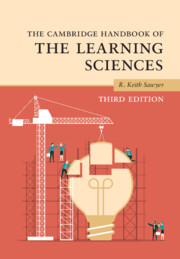Book contents
- The Cambridge Handbook of the Learning Sciences
- The Cambridge Handbook of the Learning Sciences
- Copyright page
- Contents
- Figures
- Tables
- Contributors
- Preface
- 1 An Introduction to the Learning Sciences
- Part I Foundations
- 2 Foundations of the Learning Sciences
- 3 Scaffolding
- 4 Project-Based Learning
- 5 Metacognition and Self-Regulated Learning
- 6 A History of Conceptual Change Research
- 7 Learning in Activity
- 8 Cognitive Apprenticeship
- Part II Methodologies
- Part III Grounding Technology in the Learning Sciences
- Part IV Learning Together
- Part V Learning Disciplinary Knowledge
- Part VI Moving Learning Sciences Research into the Classroom
- Index
- References
3 - Scaffolding
from Part I - Foundations
Published online by Cambridge University Press: 14 March 2022
- The Cambridge Handbook of the Learning Sciences
- The Cambridge Handbook of the Learning Sciences
- Copyright page
- Contents
- Figures
- Tables
- Contributors
- Preface
- 1 An Introduction to the Learning Sciences
- Part I Foundations
- 2 Foundations of the Learning Sciences
- 3 Scaffolding
- 4 Project-Based Learning
- 5 Metacognition and Self-Regulated Learning
- 6 A History of Conceptual Change Research
- 7 Learning in Activity
- 8 Cognitive Apprenticeship
- Part II Methodologies
- Part III Grounding Technology in the Learning Sciences
- Part IV Learning Together
- Part V Learning Disciplinary Knowledge
- Part VI Moving Learning Sciences Research into the Classroom
- Index
- References
Summary
Scaffolding is the support provided to students by the learning environment, which includes the teacher but also curricular design, technological tools, and classroom social practices. Scaffolding is a social encounter between a teacher and a student and can involve tutoring and mentoring, but is more effective when both teacher and learner participate jointly in a complex and authentic disciplinary practice. Scaffolding simplifies a task so that it is within reach of the learner; it supports learners in participating in authentic disciplinary practices even before they have mastered the discipline; it helps learners focus on the most important aspects of the problem. Effective scaffolding is adaptable and contingent on the learner’s evolving understanding – the degree of structure should be gradually reduced or “faded.” This can be done by inferring a learner’s current understanding using digital traces or dynamic software.
- Type
- Chapter
- Information
- The Cambridge Handbook of the Learning Sciences , pp. 53 - 71Publisher: Cambridge University PressPrint publication year: 2022
References
- 2
- Cited by



